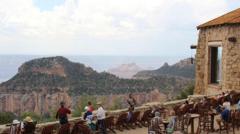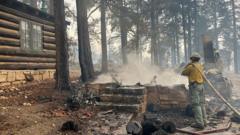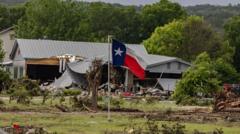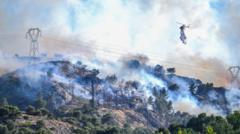Hurricane Erick is on the brink of making landfall in Mexico as a Category 4 storm, causing flash floods, school closures, and evacuations in the southern regions of Oaxaca and Guerrero.
Hurricane Erick Threatens Mexico with Category 4 Impact

Hurricane Erick Threatens Mexico with Category 4 Impact
Mexico braces for severe weather as Hurricane Erick approaches, bringing destruction and evacuation alerts.
Hurricane Erick is poised to strike Mexico's southern coast, set to make landfall west of Puerto Escondido early Thursday. The storm has already unleashed flash floods, prompting school closures and widespread evacuations in Oaxaca and Guerrero. With destructive winds and heavy rainfall, officials warned of a perilous storm surge.
As Erick approached, Civil Protection authorities declared a red alert for parts of Oaxaca and Guerrero, indicating a severe weather threat. The U.S. National Hurricane Center issued a hurricane warning along a 300-mile coastal stretch from Puerto Ángel in Oaxaca to Acapulco in Guerrero. In anticipation of the storm, over 2,000 temporary shelters were established across multiple states, with President Claudia Sheinbaum advising residents in affected areas to remain indoors and evacuate if living near waterways.
In Lagunas de Chacahua, a predominantly fishing community in Oaxaca, over 100 residents took refuge in schools after evacuations. Streets in the port city of Salina Cruz were flooded, leaving vehicles submerged. Local police and emergency crews assisted drivers and cleared debris from roadways.
Ahead of the storm, residents in Puerto Escondido secured their properties by boarding up windows, and tourists were advised to remain in their hotels. Schools also remained closed for a second consecutive day, confirmed Emilio Montero Pérez, the director of the Oaxaca State Institute of Public Education.
Erick rapidly intensified, generating winds capable of uprooting trees, displacing items, and causing significant property damage. Authorities are on alert, monitoring rivers and dams for potential flooding.
The Pacific storm season, which extends through November 30, has already seen its fifth named storm this year. This follows the devastating aftermath of Hurricane Otis from 2023, which wreaked havoc across the same areas.
John Yoon, a reporter for Times, provides ongoing coverage of this unfolding situation.
As Erick approached, Civil Protection authorities declared a red alert for parts of Oaxaca and Guerrero, indicating a severe weather threat. The U.S. National Hurricane Center issued a hurricane warning along a 300-mile coastal stretch from Puerto Ángel in Oaxaca to Acapulco in Guerrero. In anticipation of the storm, over 2,000 temporary shelters were established across multiple states, with President Claudia Sheinbaum advising residents in affected areas to remain indoors and evacuate if living near waterways.
In Lagunas de Chacahua, a predominantly fishing community in Oaxaca, over 100 residents took refuge in schools after evacuations. Streets in the port city of Salina Cruz were flooded, leaving vehicles submerged. Local police and emergency crews assisted drivers and cleared debris from roadways.
Ahead of the storm, residents in Puerto Escondido secured their properties by boarding up windows, and tourists were advised to remain in their hotels. Schools also remained closed for a second consecutive day, confirmed Emilio Montero Pérez, the director of the Oaxaca State Institute of Public Education.
Erick rapidly intensified, generating winds capable of uprooting trees, displacing items, and causing significant property damage. Authorities are on alert, monitoring rivers and dams for potential flooding.
The Pacific storm season, which extends through November 30, has already seen its fifth named storm this year. This follows the devastating aftermath of Hurricane Otis from 2023, which wreaked havoc across the same areas.
John Yoon, a reporter for Times, provides ongoing coverage of this unfolding situation.




















